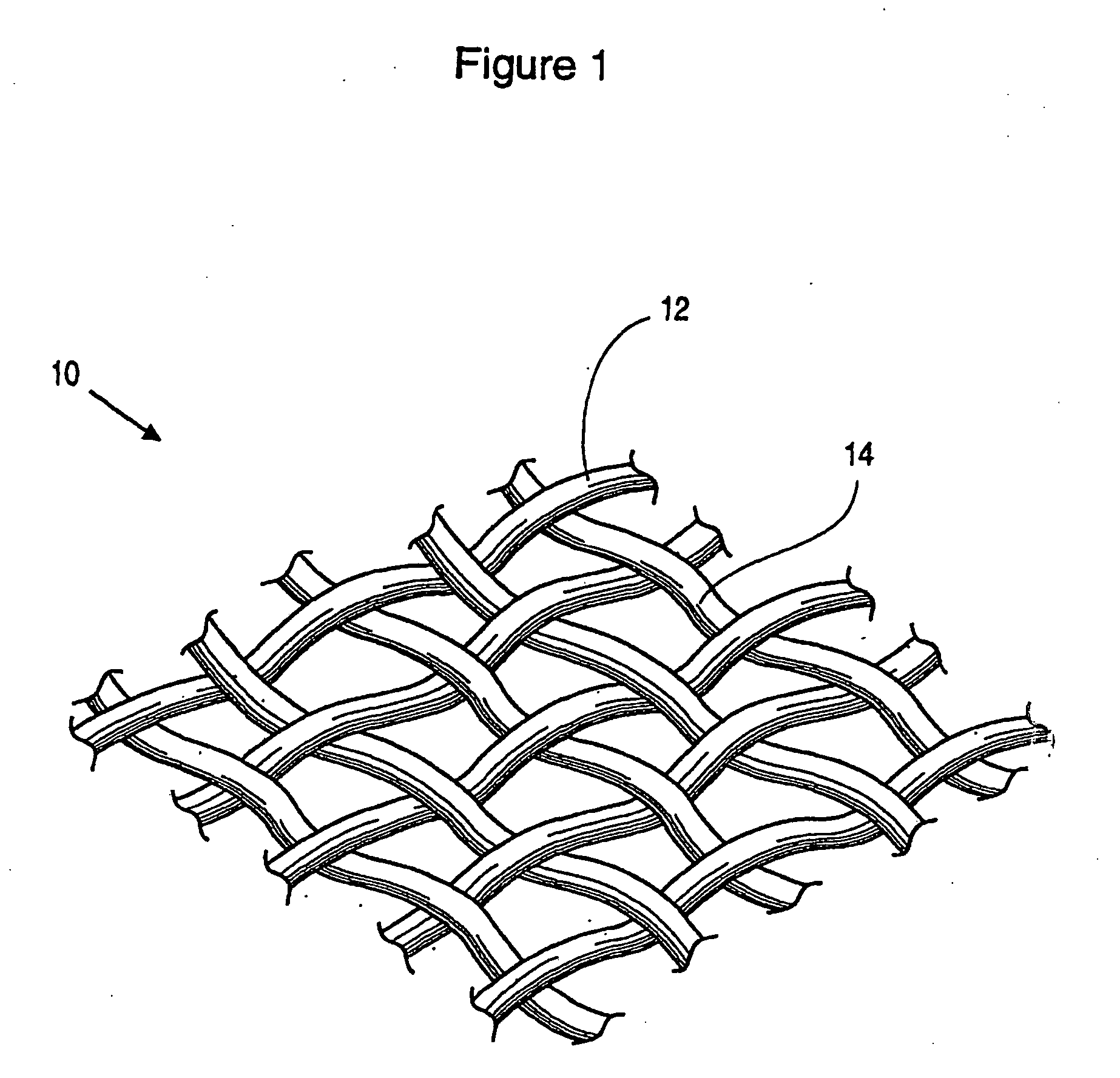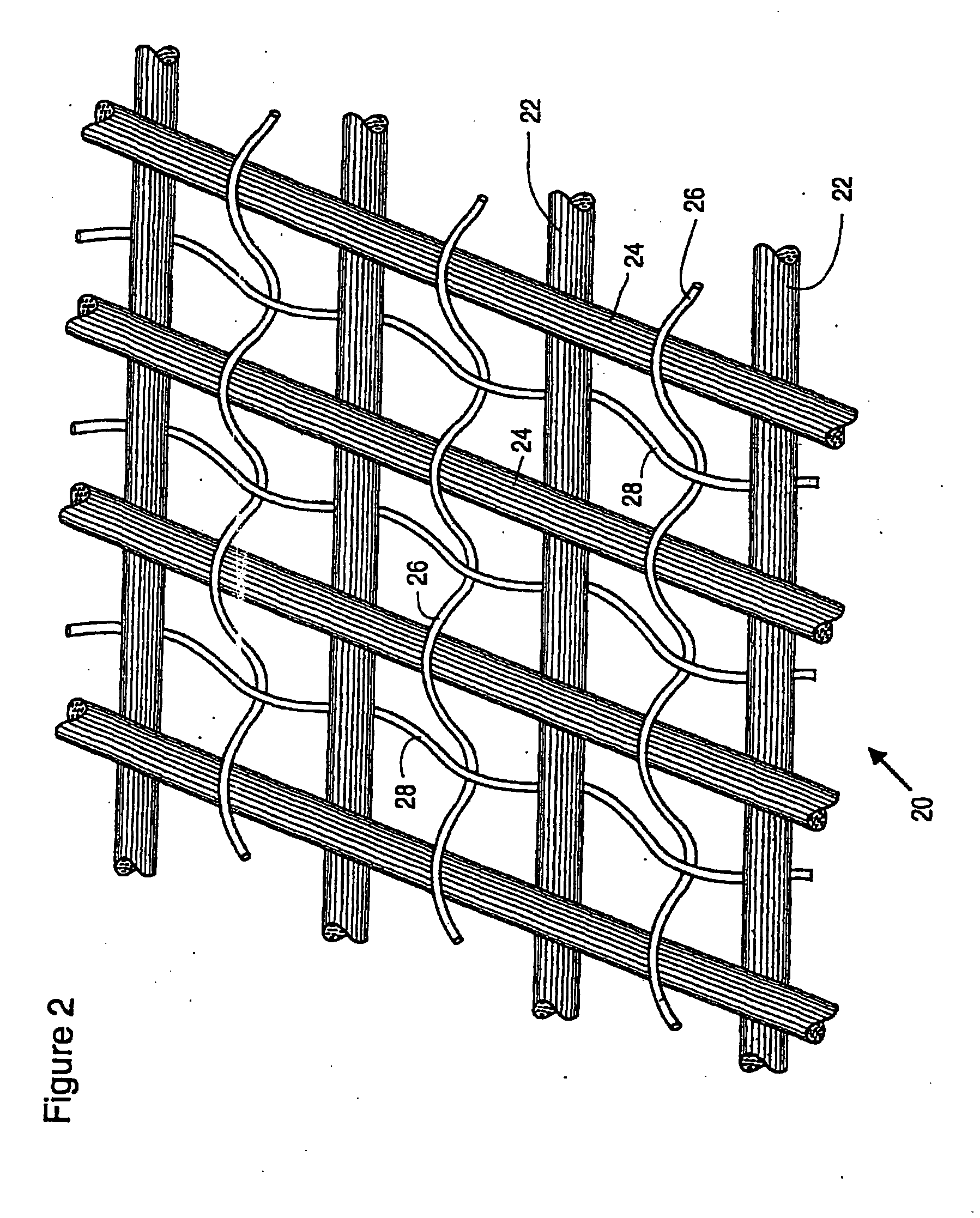Densely woven quasi-unidirectional fabric for ballistic applications
a quasi-unidirectional fabric and dense weaving technology, applied in weaving, protective fabrics, knitting, etc., can solve the problems of easy penetration of armor layers, excessive interstices between yarns, and material not widely accepted in the ballistic field
- Summary
- Abstract
- Description
- Claims
- Application Information
AI Technical Summary
Benefits of technology
Problems solved by technology
Method used
Image
Examples
example i
[0093] An experimental fabric was made with 1330 dtex (i.e., 1,200 denier) Spectra® (extended chain polyethylene) warp and fill yarns and 78 dtex nylon warp and fill yarns. The Spectra® yarn was twisted while the nylon yarn was not twisted. The Spectra® yarn was fed into the loom from one beam while the nylon was fed from a second beam.
[0094] The different warp yarns were alternated in the fabric, i.e. a Spectra® yarn followed by a nylon yarn, repeated across the fabric. The fill yarn was also alternately Spectra® and nylon. The fabric was woven as a plain weave fabric. To reflect the difference in strength, modulus and diameter, the Spectra yarns were unidirectional while the nylon yarns formed a crimped fabric supporting the Spectra yarns. The count of the fabric was 21 Spectra per inch and 21 nylon yarns per Inch in both the warp and fill direction. The maximum number of 1200 denier yarns that can be woven into a plain weave is 25 ends per inch. The ratio of the diameter of the ...
example ii
[0097] An experimental fabric was made with 1330 dtex Spectra® warp and fill yarns and 78 dtex nylon warp and fill yarns. The Spectra yarn was twisted while the nylon yarn was not twisted. The Spectra® yarn was fed into the loom from one beam while the nylon was fed from a second beam.
[0098] The different warp yarns were alternated in the fabric, i.e. a Spectra® yarn followed by a nylon yarn, repeated across the fabric. The fill yarn was also alternately Spectra® and nylon. The fabric was woven as a plain weave fabric. To reflect the difference in strength, modulus and diameter, the Spectra® yarns were unidirectional while the nylon yarns formed a crimped fabric supporting the Spectra® yarns. The count of the fabric was 16 Spectra per inch and 16 nylon yarns per inch in both the warp and fill direction. The maximum number of 1200 denier yarns that can be woven into a plain weave is 25 ends per inch. The ratio of the diameter of the encapsulating yarn to the ballistic yarn was 5.4%....
example iii
[0100] A fabric was made with 1330 dtex Spectra® warp and fill yarns and 78 dtex nylon warp and fill yarns. The Spectra® yarn was twisted while the nylon yarn was not twisted. The Spectra® yarn was fed into the loom from one beam while the nylon was fed from a second beam. The different warp yarns were alternated in the fabric, i.e. a Spectra® yarn followed by a nylon yarn, repeated across the fabric. The fill yarn was also alternately Spectra® and nylon. The fabric was woven as a plain weave fabric. To reflect the difference in strength, modulus and diameter, the Spectra® yarns were unidirectional while the nylon yarns formed a crimped fabric supporting the Spectra® yarns. The count of the fabric was 10.5 Spectra® per inch and 10.5 nylon yarns per inch in both the warp and fill direction. The maximum number of 1200 denier yarns that can be woven into a plain weave is 25 ends per inch. The ratio of the diameter of the encapsulating yarn to the ballistic yarn was 5.4%. The finished f...
PUM
| Property | Measurement | Unit |
|---|---|---|
| linear density | aaaaa | aaaaa |
| linear density | aaaaa | aaaaa |
| elongation | aaaaa | aaaaa |
Abstract
Description
Claims
Application Information
 Login to View More
Login to View More - R&D
- Intellectual Property
- Life Sciences
- Materials
- Tech Scout
- Unparalleled Data Quality
- Higher Quality Content
- 60% Fewer Hallucinations
Browse by: Latest US Patents, China's latest patents, Technical Efficacy Thesaurus, Application Domain, Technology Topic, Popular Technical Reports.
© 2025 PatSnap. All rights reserved.Legal|Privacy policy|Modern Slavery Act Transparency Statement|Sitemap|About US| Contact US: help@patsnap.com



